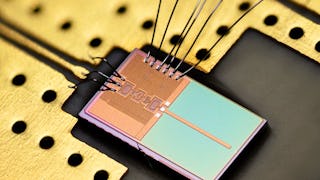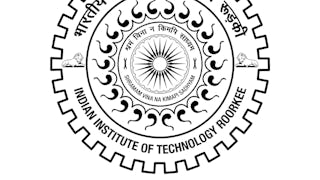This unique Master-level course provides you with in-depth know-how of microwave engineering and antennas. The course combines both passive and active microwave circuits as well as antenna systems. Future applications, like millimeter-wave 5G/beyond-5G wireless communications or automotive radar, require experts that can co-design highly integrated antenna systems that include both antennas and microwave electronics. We will provide you with the required theoretical foundation as well as hands-on experience using state-of-the-art design tools.

Gain next-level skills with Coursera Plus for $199 (regularly $399). Save now.

(153 reviews)
Recommended experience
What you'll learn
Module 1: Introduction of the course, including an overview of applications and trends.
Module 2: Passive microwave circuits, covering transmission-line based circuits including impedance matching, power combiners, filters.
Module 3: Antenna theory. This provides an introduction into antenna theory, including phased arrays.
Module 4: Active microwave circuits. Extension towards amplifiers, including low-noise amplifiers.
Skills you'll gain
Details to know

Add to your LinkedIn profile
See how employees at top companies are mastering in-demand skills

There are 9 modules in this course
In this short video the lecturers will introduce themselves and will provide a general overview of the scope of the course. The lecturers all have a solid academic and industrial background and are embedded in the Center for Wireless Technology Eindhoven (CWT/e) of Eindhoven University of Technology, The Netherlands.
What's included
1 video
In week 1 we will provide you with an introduction to the course including an overview of applications (Module 1). In addition, we will start with Passive Microwave Circuits (Module 2) by introducing transmission line theory. We will also introduce the design-challenge in which you will develop your own 4-channel phased array system including beamformer and active microwave electronics. Next to this, we will show you how to use the open-source design tool QUCS. We will use this tool for the design of passive and active microwave circuits.
What's included
6 videos7 readings3 assignments2 discussion prompts
In week 2 we will continue with Passive Microwave Circuits (Module 2) by introducing the concept of microwave networks. We will use this concept by analyzing power combiners. In addition, you will start your design challenge by designing a 4-channel beamformer network.
What's included
3 videos4 readings3 assignments1 peer review2 discussion prompts
In week 3 we will finalize our journey into Passive Microwave Circuits (Module 2) by first introducing the Smith chart and by applying it for the design of matching circuits. Next to this, we will show how you can design microwave filters.
What's included
4 videos4 readings4 assignments1 discussion prompt
In week 4 we will start with Antenna Theory (Module 3) and introduce the concept of antennas by exploring the main characteristics of antennas, including directivity, antenna gain and input impedance. We will show how these parameters can be used to determine the range of wireless system or radar. As a first real antenna concept, we will introduce phased-array antennas. In addition, the design challenge will continue with an antenna design. This includes an introduction into the antenna design CST.
What's included
5 videos6 readings5 assignments1 peer review2 discussion prompts
In this week the real hard-core theoretical antenna framework is presented. Starting from Maxwell's equations we will derive the general expression for the radiated fields by any antenna configuration. The framework will be applied to the electric dipole and wire antennas. In addition, your will participate in a workshop that introduces a state-of-the-art antenna design tool.
What's included
4 videos4 readings4 assignments1 discussion prompt
In this week we will extend our theoretical framework with magnetic sources. In this way, you can use the framework to analyze aperture antennas. We will show this by analyzing horn antennas, reflector antennas and microstrip antennas. We will also show how microstrip antennas can be used to create a phased-array system. We will finalize the week by providing you with some background knowledge in numerical methods. This will help you to understand the underlying principles of numerical electromagnetics used in commercial tools such as ADS and CST.
What's included
7 videos7 readings6 assignments1 discussion prompt
In this week we will extend the theory on microwave circuits towards active circuits which make use of transistors to realize amplifiers. We will start by introducing the various definitions which are used to describe the gain of an amplifier. As a next step we will present a design methodology for low-noise amplifiers. You will also start with the last part of your design challenge by designing a low-noise amplifier.
What's included
4 videos5 readings2 assignments1 peer review2 discussion prompts
In the last week of the course we will dive deeper into the design of microwave amplifiers by exploring by exploring the stability conditions of amplifiers. When stability is secured, the amplifier performance can be further optimized by proper design of the input and output matching circuits. For this purpose the concept of constant-gain circles can be used.
What's included
4 videos4 readings2 assignments1 discussion prompt
Instructors



Offered by
Explore more from Electrical Engineering
 Status: Preview
Status: PreviewEindhoven University of Technology
 Status: Preview
Status: Preview Status: Preview
Status: Preview Status: Preview
Status: Preview
Why people choose Coursera for their career




Learner reviews
153 reviews
- 5 stars
80.39%
- 4 stars
11.11%
- 3 stars
2.61%
- 2 stars
1.96%
- 1 star
3.92%
Showing 3 of 153
Reviewed on Jun 17, 2022
A very challenging but rewarding course, rightly so.
Reviewed on Apr 2, 2024
I had very good Experience by solving the assignment question. This course is very much useful for my research related work towards antenna design. Thank you to the whole Coursera team.
Reviewed on Nov 25, 2022
The course helps me reinforce knowledge about antenna design, and I have applied it in my work

Open new doors with Coursera Plus
Unlimited access to 10,000+ world-class courses, hands-on projects, and job-ready certificate programs - all included in your subscription
Advance your career with an online degree
Earn a degree from world-class universities - 100% online
Join over 3,400 global companies that choose Coursera for Business
Upskill your employees to excel in the digital economy
Frequently asked questions
To access the course materials, assignments and to earn a Certificate, you will need to purchase the Certificate experience when you enroll in a course. You can try a Free Trial instead, or apply for Financial Aid. The course may offer 'Full Course, No Certificate' instead. This option lets you see all course materials, submit required assessments, and get a final grade. This also means that you will not be able to purchase a Certificate experience.
When you purchase a Certificate you get access to all course materials, including graded assignments. Upon completing the course, your electronic Certificate will be added to your Accomplishments page - from there, you can print your Certificate or add it to your LinkedIn profile.
Yes. In select learning programs, you can apply for financial aid or a scholarship if you can’t afford the enrollment fee. If fin aid or scholarship is available for your learning program selection, you’ll find a link to apply on the description page.
More questions
Financial aid available,
¹ Some assignments in this course are AI-graded. For these assignments, your data will be used in accordance with Coursera's Privacy Notice.

